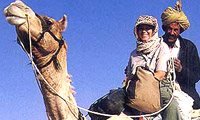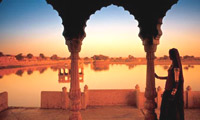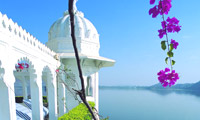No more spectacular land exists
in the whole world, no more stirring histories are as concentrated
in any one region as Rajasthan, where mountains have been
thrown up from the burning sands of the desert, where legends
have created lakes and polls, where a proud and mysterious
people have built forts and palaces, temples, and mansions.
Here, where kingdoms once fought over codes of honor and
chivalry rather then wealth and power, families still feud
long after the last battle has been consigned to the pages
of history.
The glorious past called "Rajputana"
Early History
Rajasthan is the north-western region of India, and has
remain independent from the great empires. Buddhism failed
to make substantial inroad here; the Mauryan empire (321-184
BC), whose most renowned emperor, Ashoka, Converted to Buddhism
in 261 BC, had minimal impact in Rajasthan, However, there
are Buddhist caves and Stupas (Buddhist Shrines) at Jhalawar,
in Southern Rajasthan.
Ancient Hindu scriptural epics make reference to sites in
present-day Rajasthan. The Holy Pilgrimage site of Pushkar
is mentioned in both the Mahabharata and Ramayana.
Emergence of the Rajputs
The fall of the Gupta Empire, which held dominance in northern
India for nearly 300 years until the early 5th Century,
was followed by a period of instability as various local
chieftains sought to gain supremacy. Power rose and fell
in northern India. Stability was only restored with the
emergence of the Gurjara Partiharas, the earliest of the
Rajput (from 'Rajputra', or Sons of Princes) dynasties which
were later to hold the balance of power throughout Rajasthan.
Whatever their actual origins, the Rajputs have evolved
a complex mythological genealogy. This ancestry can be divided
into two main branches: the Suryavansa, or Race of the Sun
(Solar Race), which claims direct descent from Rama; and
the Induvansa, or Race of the Moon (Lunar race), which claims
descent from Krishna, Later a third branch was added, the
Agnikula, or 'Fire Born'. These people claim they were manifested
from the flames of a sacrificial fire on Mt.Abu From these
three Principal races emerged the 36 Rajput clans.
The Rajput clans gave rise to dynasties such as the
Chauhans, Sisodias, Kachhwahas and Rathores. Chauhans of
the Agnikula Race emerged in the 12th century and were renowned
for their valour. Their territories included the Sapadalksha
kingdom, which encompassed a vast area including present-
day Jaipur, Ranthambhore, part of Mewar, the western portion
of Bundi district, Ajmer Kishangarh and even, at one time,
Delhi. Branches of the Chauhans also ruled territories know
as Ananta (in present-day Shekhawati) and Saptasatabhumi.
The Sisodias of the Suryavansa Race, Originally from Gujarat,
migrated to Rajasthan in the mid-7th Century and reigned
over Mewar, which encompassed Udaipur and Chittorgarh.
The Kachhwahas, originally from Gwalior in Madhya Pradesh,
travelled west in the 12th century. They built the massive
fort at Amber, and later shifted the capital to Jaipur.
Like the Sisodias, they belonged to the Suryavansa Race.
Also belonging to the Suryavansa Race, the Rathore (earlier
known as Rastrakutas) traveled from Kanauj, in Uttar Pradesh.
Initially they settled in Pali, south of present-day Jodhpur,
but later moved to Mandore in 1381 and ruled over Marwar
(Jodhpur). Later they started building the stunning Meherangarh
(fort) at Jodhpur.
The Bhattis, who belong to the Induvansa Race, driven from
their homeland in the Punjab by the Turks, installed themselves
at Jaisalmer in 1156. They remained more of less entrenched
in their desert Kingdom untill they were integrated into
the state of Rajasthan following Independence.
Rajasthan colorful & diversified culture
Rajasthan is famous for its rich variety of colors, languages,
folk music and art work.
Language
Hindi is the official language of the state. But the principal
language is "Rajasthani", and the four major dialects
are Marwari in the west, Jaipuri in the east, Malwi in the
southeast and Mewati in the northeast. But Hindi language
is replacing Rajasthani. Moreover, you will find English
speaking people in all the major cities, and in remote villages
also you will find someone who can speak and understand
English. But other languages are completely unknown. You
may ask Tour Operators to help you on this and they do have
guides who knows almost all the languages.
Music & dance
Every region has its own very dialect of music and dance.
The Ghoomar dance from Udaipur and Kaibeliya dance of Jaisalmer
have international recognition. Folk music is a vital part
of Rajasthan culture. Songs are used to tell the legendary
battles of Rajputs. Folk songs are commonly ballads which
relate heroic deeds, love stories, and religious or devotional
songs known as bhajans and banis and often accompanied by
musical instruments like dholak, sitar, sarangi etc.
Religion
Hindusim is the main religion of Rajasthan. Other significant
religious groups in the state are the Jains and the Muslims.
There are many local folk heros and local deities such as
Pabuji, Ramdeoji, Gogaji, Mehaji, Tejaji & Harbhuji.
Art & architecture
Rajasthan is known for its traditional and colorful art.
The block prints, tye and die prints, Bagaru prints, Sanganer
prints, zari embroidery are major export products from Rajasthan.
Handicraft items like wooden furniture and handicrafts,
carpets, blur potteries are some of the things you will
find here. Rajasthan is shoppers paradise.
Rajasthan is famous for the majestic forts,
intricately carved temples and decorated havelis. Jantar
Mantar, Dilwara Temples, Chittorgrah Fort, Lake Palace Hotel,
City Palaces, Jaisalmer Havelis are true architectural heritage.
Rajasthan city information
Brief profile of some mportant cities of Rajasthan, for
other details like places to see, tour operators, hotels,
restaurants and other travel information and other cities
of Rajasthan click here.
Ajmer
120 km (78 miles) west of Jaipur, was founded by great Raja
Prithviraj Chauhan in 7th century. Ajmer is known for Dargah
of Khwaja Mu'in-ud-din Chisti (1142-1236) and Ana Sagar
Lake. Also known for the famous boarding schools Sophia
college (Girls) and Mayo college (Boys).
Bharatpur
175 km from Jaipur & 185 km from Delhi, is know for
the Keoladeo Ghana National Park (Bird Sanctuary) and also
a halting place on the way from Agra (55 km). The only city
that was ruled by Jats. And you can also see the old fort
and museum.
Bikaner
In route on your way from Jaipur (330 km) to Jaisalmer (320
km) was founded in 15th century by Rao Bika. Known for durries,
carpets, hand painted lamp shades, and mojari slippers.
Also for the camel safari and Junagarh Fort.
Chittorgarh
110 km from Udaipur and 300 km from Jaipur was founded by
Bappa Rawal in 8th century. Known for the massive fort 3
mile long and 495 feet high. Mirabai, 16th century poet
and saint was from here. Also known fro Vijaystambha, Kirtistambha
(Tower of Victory), and Rani Padmini.
Jaipur
Capital city of Rajasthan also known as "Pink City"
is about 250 km from Delhi, and your starting point for
Rajasthan. Founded by Raja Sawai Jai Singh II in 1727 is
famous for Amber Fort, jantar mantar, hawa mahal, city palace
& Sisodia Rani Ka Bagh. Also for the textile block prints,
semi precious jewelry, handicraft items and Raj Mandhir
(Movie theater).
Jodhpur
250 km from Jaipur, also called "Blue City" is
second city of Rajasthan. Founded by Rao Jodha is famous
for Mehrangarh Fort, Umed Bhawan Palace, museum and handicrafts.
Jaisalmer
275 Kms from Jodhpur, also called "Golden City"
was founded by Rao Jaisal. Famous for the Jaisalmer Fort,
Patwon-ki-haveli, sand dunes, and ideal for camel rides
and safaris.
Mount Abu
190 Kms from Udaipur & 27 Km from Abu, is the only hill
resort of Rajasthan. Famous for Dilwara Temples, Guru Shikar,
and Nakki Lake.
Pushkar
14 km from Ajmer, is famous for the Pushkar Fair and Brahma
Temple and beautiful view of desert at sunset.
Sariska
110 km from Jaipur and 35 km from Alwar is famous for the
Tiger Reserve Sanctuary.
Sawai Madhopur (Ranthambore)
135 km from Jaipur and 27 km from Sawai Madhopur is famous
for the Ranthambore National Park, Tiger Reserve Project.
Udaipur
420 km from Jaipur on Jaipur-Mumbai highway also called
"City of Lakes" was founded by Maharana Udai Sigh
II in 1568. Also called "Venice of East" is famous
for lakes, palaces (Lake Palace Hotel), city palace, puppet
museum, miniature paintings, and temples (Nathadwara 50
km and Eklangji 20 km from Udaipur)


